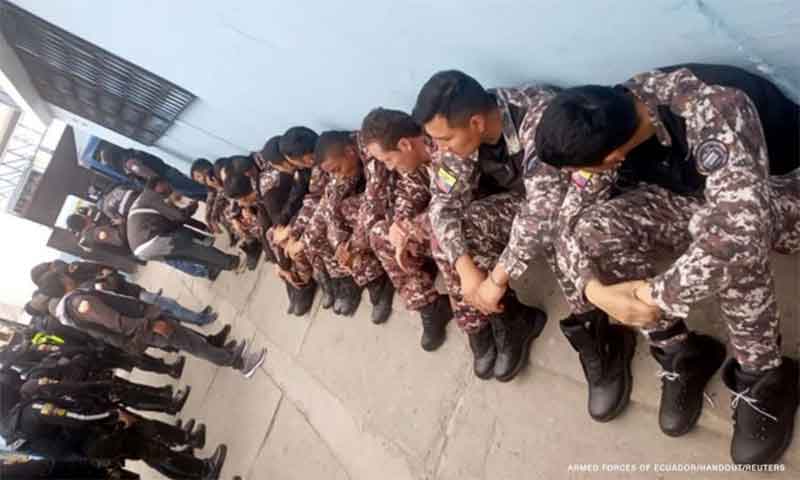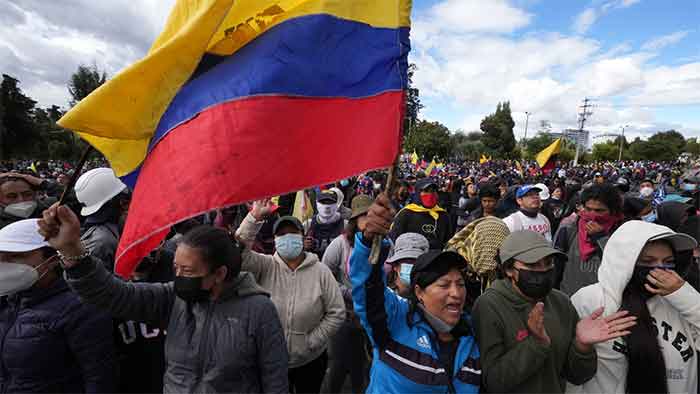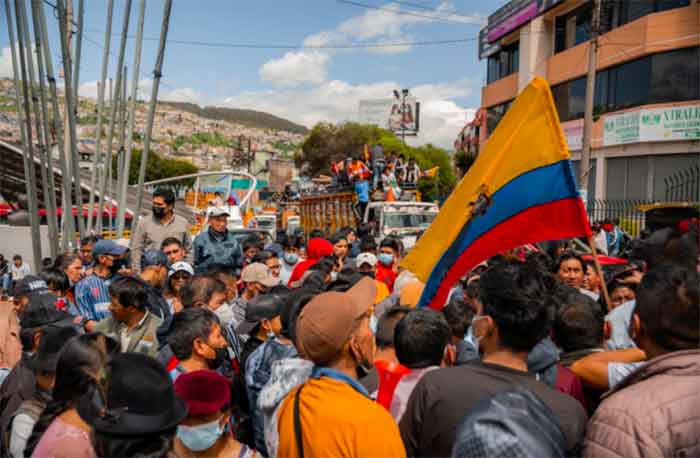
All prison guards and administrative employees held hostage by inmates at correctional facilities across Ecuador have now been freed, the national prisons agency SNAI said Saturday night. The SNAI prison agency on Saturday said all hostages had been freed.
SNAI said 158 guards and 20 administrative staff had been seized since last Monday in several prisons.
The incident is part of an escalating security crisis in the country that worsened this week.
Ecuadorean soldiers were patrolling at the shared border with Colombia on Saturday as part of the operation. Ecuador’s security forces worked Sunday to regain control of prisons that had fallen into the hands of gang members, after securing the release of nearly 180 officials held hostage inside the jails.
Gunmen stormed a TV station on air, unexplained explosions were set off in several cities and police officers were kidnapped.
The government declared a state of emergency last week and said that so far, more than 1,100 people have been arrested.
The country’s simmering security crisis erupted last week as the government and powerful narco gangs declared all-out war on each other, after the prison escape of a dangerous drug lord.
President Daniel Noboa celebrated the releases in a post on X, the former Twitter.
“Congratulations to the patriotic, professional and courageous work of the armed forces, national police and the SNAI (…) for achieving the release of the prison guards and administrative staff held in the detention centers of Azuay, Canar, Esmeraldas, Cotopaxi, Tungurahua, El Oro and Loja,” he wrote.
The government declared a state of emergency and curfew, infuriating gangsters who declared “war” against civilians and security forces.
Noboa in turn said the country was “in a state of war” against 22 gangs.
He deployed over 22,000 security forces to the streets, who have frisked and stripped down young men in search of the tattoos identifying them as a member of one of the gangs.
A CNN report said:
Ecuadorian President Daniel Noboa welcomed the news and congratulated SNAI, the armed forces and the national police for securing their release.
The National Police of Ecuador had earlier said that people had been freed from prisons in Esmeraldas city in northwestern Ecuador as well as Tungurahua province on Saturday after mediation by the Catholic church.
The agency had also reported an armed confrontation at a prison in the southern region of El Oro between inmates and members of the armed forces and the National Police.
One prison guard was killed and another was injured in the facility, SNAI said.
The hostage taking at Ecuador’s prisons comes amid a wave of violence sweeping the country that has included explosions and kidnappings of police.
In a separate incident this week, masked gunmen armed with explosives stormed the set of a live television broadcast. Television anchor Jorge Rendon described the takeover as an “extremely violent attack” and said that he knew of one person who was shot and another injured by the assailants.
The situation has struck fear among many Ecuadorians and the country is “living a real nightmare,” former President Rafael Correa said in a video shared on social media.
Ecuador, home to the Galapagos islands and a tourist-friendly dollar economy, was once known as an “island of peace,” nestled between two of the world’s largest cocaine producers, Peru and Colombia.
But instability has been growing in the Latin American country for years.
The immediate trigger of the latest incidents was the recent escape of a high-profile gang leader, Adolfo “Fito” Macías, from a prison in the city of Guayaquil.
Fito is the leader of Los Choneros, one of Ecuador’s most feared gangs – linked to maritime drug trafficking to Mexico and the United States, that also works with Mexico’s Sinaloa cartel and the Oliver Sinisterra Front in Colombia, according to authorities.
He was sentenced to 34 years in prison in 2011 for crimes including drug trafficking and murder. A state of emergency was declared following his escape.
Security forces have struggled to confront prison gangs inside overcrowded facilities, where inmates often take control of branches of the penitentiaries and run criminal networks from behind bars, according to authorities.
The search for Fito continues. More than 3,000 police officers and members of the armed forces have been deployed to find him. Authorities have not yet pinpointed the exact time and date that he escaped prison.
Before his assassination at a political rally in the capital Quito last August, late presidential hopeful Fernando Villavicencio revealed he had been threatened by Fito and had been warned against continuing with his political campaign against gang violence.
Villavicencio said the country had become a “narco state” and promised a crackdown on gang crime and corruption that has gripped the country in recent years.
An AFP report said:
Inmates rioted in jails where gangs wield outsize control, taking prison guards and administrative workers hostage, while on the streets a wave of violence has left 19 people dead.
Unverified images on social media of looting, brutal murders and other attacks have struck terror into the population.
On Sunday the army shared videos of prison walls being blown up, and declared “total control” of a prison in the city of Cuenca where 61 employees had been held hostage, according to the mayor.
They also shared images of hundreds of inmates, shirtless and barefoot, lying on the ground during the operation.
On Saturday the government first announced the release of 42 hostages, before the remaining 136 were set free, from prisons across seven provinces.
Images broadcast by the police showed the guards, many in tears, exhausted and supported by their colleagues shortly after their release.
Once a bastion of peace situated between major cocaine producers, Ecuador has been plunged into crisis after years of expansion by the transnational cartels that use its ports to ship the drug to the United States and Europe.
It is in the prisons that much of the gang wars are fought, with brutal clashes between inmates leaving more than 460 dead, many beheaded or burned alive, since February 2021.
Ecuador’s murder rate quadrupled between 2018 and 2022, as the criminal gangs found a foothold in the country.
Last year was the worst yet, with 7,800 murders and a record 220 tons of drugs seized.
Noboa has announced he plans to build two “super maximum” security prisons with a capacity for more than 3,000 people, with proposals for future “prison ships” also on the table.
A Reuters report said:
Images on social media shared by Ecuadorean armed forces showed shirtless prisoners on their knees with hands on their heads as armed soldiers entered the seven jails that were the scenes of a hostage crisis that ended Saturday evening.
“The national police are respecting the human rights of these people. We are doing so in a very calm manner,” Norman Cano, police chief at the Esmeraldas prison, said on social media.
5 Points To Understand A Country Broken By Neoliberalism
Gerardo Szalkowicz writes in Spanish Tiempo Argentino:
People across the world were shocked to see a drug gang waving rifles and grenades in the TC Television studios in Guayaquil, and the scene was perhaps the cinematic peak of successive days of explosions, riots, lootings, shootings, car explosions, and widespread panic that has paralyzed the country.
However, the shocking and unprecedented episode on the public channel in Guayaquil—and the events that preceded and followed it—are just the latest chapter in a spiral of organized violence that has lasted for about five years and that has metastasized in the last two. It is the sad metamorphosis of a country that went from being the second safest in Latin America to becoming the most violent, with a homicide rate that has grown almost 800% since 2019.
The Current Powder Keg
Gerardo Szalkowicz writes:
The catalyst of the past several days was the prison escape of two drug lords in the midst of riots and kidnappings of police officers in half a dozen prisons. The prison crisis is the most visible face of the hecatomb: the constant massacres, generally due to confrontation between gangs, have left more than 460 prisoners dead since 2021.
The young president Daniel Noboa, who took office a month and a half ago to complete Guillermo Lasso’s term, responded by declaring a state of emergency and a curfew, which ended up causing a flurry of armed attacks and assassination attempts throughout the country that included the viral takeover of the channel.
Faced with the widespread chaos, and after receiving support from the entire political spectrum—including the exiled former president Rafael Correa, Noboa issued a new decree that recognizes the state of “internal armed conflict” and orders the military forces to neutralize 22 organizations which it declares as “terrorist groups.” The debut day of this total war on the gangs left at least 13 dead and 41 arrested.
The country went into shock: in-person classes were suspended, most businesses closed, and the population barricaded themselves in their homes. War tanks roam the empty streets while sources of violence and clashes multiply, predicting a bloody uncertain outcome.
Five Basic Points
Gerardo Szalkowicz writes:
The following are some keys that try to unravel how this model of daily violence and death governed by narco-criminal gangs was established:
The international factor. Ecuador is located in the middle of Colombia and Peru, the world’s largest producers of cocaine. The presence of the FARC in southern Colombia functioned as a kind of blockade for the expansion of the cartels towards Ecuador, but the signing of the peace agreement in 2016, and the subsequent demobilization of the guerrilla, deconfigured that border territory and opened the floodgate to the criminal economy to establish its operations, mainly in the ports of Guayaquil and Esmeraldas.
Furthermore, within the framework of a reconfiguration of drug routes, Ecuador became a large regional center for the storage, processing and distribution of drugs destined mainly for the United States and Europe. In a short time, more than twenty gangs proliferated, operating in a fragmented manner, in many cases as subcontractors of the large cartels of Mexico and Colombia.
The dismantling of the State. The above is linked to the shift in the economic model implemented with the betrayal of Lenín Moreno since 2018 and continued by former banker Guillermo Lasso. The neoliberal prescription of adjustment, public austerity, and shrinking of the State led to the decrease in institutional presence, weakening border control and facilitating the penetration of gangs.
Financial deregulation. In line with the neoliberal structural reforms agreed on with the IMF, controls on the circulation of capital, offshore companies, and money laundering were also reduced. The dollarized economy, which facilitates money laundering, closed the perfect circle for drug trafficking operations.
Penetration in institutions. The gangs ability to maneuver and their omnipresence of them controlling territories and prisons is only explained by the expansion of their tentacles and reach in important sectors of the security forces, the judiciary, and to some political figures.
In mid-December, the prosecutor’s office launched “Operation Metastasis,” which led to the arrest of 29 people, including judges, prosecutors, police officers, and lawyers for links to organized crime. Already in 2021, the U.S. had withdrawn the visas of four senior police officers whom it called “narco-generals.”
A regional plan. The plot that is destroying Ecuador has local particularities but responds to a model that was firmly established in the 1980s in Mexico, Colombia and some Central American countries, and that in recent years has spread, on different scales, throughout the region. It is about the paramilitarization of territories to sow terror, dismantle the social fabric and keep the populations subjugated, while in parallel a structure of millionaire businesses is rebuilt. Old and new strategies of domination to continue guaranteeing control of the Latin American landscape.















































